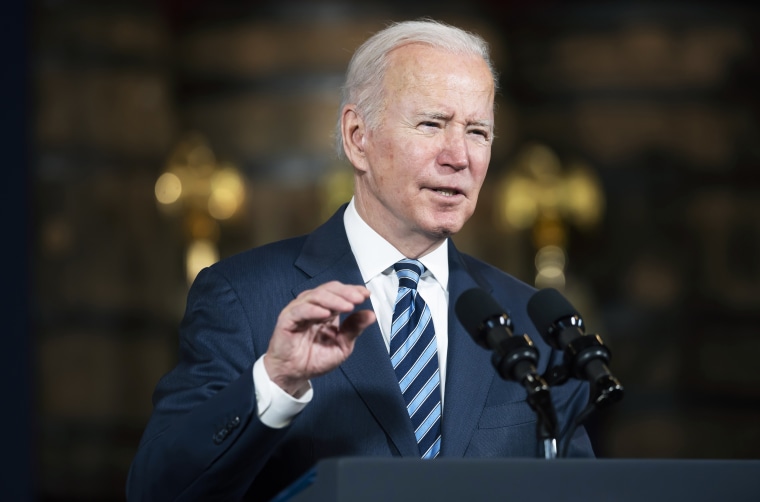A U.S. digital currency could be on the horizon.
The Biden administration is putting its support behind the research and development of a “U.S. Central Bank Digital Currency,” or CBDC.
The move is part of a sweeping executive order President Joe Biden signed Wednesday instructing the federal government to explore possible uses of and regulations for digital assets like cryptocurrencies.
"My Administration places the highest urgency on research and development efforts into the potential design and deployment options of a United States CBDC," the executive order reads.
The order asks for a wide variety of agencies to begin research and submit reports on a variety of issues surrounding digital currencies, from design and security to financial and societal impacts.
“We know the implications of potentially issuing a digital dollar are profound. They’re extraordinarily wide-ranging,” a senior administration official told reporters on a call Tuesday.
Although a U.S. digital currency would not necessarily change much in terms of everyday experiences like buying goods and services, economists say it could transform central and commercial banking, as well as government sanctions, banking accessibility and taxes.
“The potential here is enormous, and it’s very interesting,” said David Yermack, a professor and the chair of the finance department at New York University.
The executive order will call on the government to investigate the technical needs for a digital currency and advocate for the Federal Reserve to continue its research and development, according to a fact sheet released by the White House.
The Fed published a white paper in January about potentially creating a CBDC that would complement existing payment systems. It found that a CBDC could make payments cheaper and easier for consumers but might also pose a risk to the stability of the U.S. financial system.
In its fact sheet, the administration said it also would take steps to “mitigate the illicit finance and national security risks posed by the illicit use of digital assets by directing an unprecedented focus of coordinated action across all relevant U.S. Government agencies to mitigate these risks.”
The U.S. would not be the first country with a digital currency. China has introduced its own CBDC, with more than 140 million people having opened digital “wallets,” and many other countries have either rolled out or are developing digital currencies. The Bahamas’ Sand Dollar is considered among the world's most successful digital currencies.
Yermack said the move by the Biden administration pointed to what he believes is a certain inevitability of the broader move toward digital currencies.
“It’s not a question of if but when,” he said. “Once the central banks start co-opting the technology, it’s pretty much game over."
While the administration fact sheet did not provide any details about how a U.S. digital currency might work, Yermack suggested that the functionality could be reasonably simple, with transactions flowing directly to and from the Fed, sidestepping banks and payment systems and creating near-seamless flows of cash.
It is a simple concept with the potential for widespread ramifications. Yermack said a broadly embraced digital currency would pose existential questions for banks and many other financial services focused on facilitating payments.
“Bill Gates famously said there will always be banking but there will not always be banks,” Yermack said.
Digital currencies also open up new possibilities for how the government exercises policy, said Michael Bordo, a professor of economics and the director of the Center for Monetary and Financial History at Rutgers University in New Jersey.
A digital currency could make the kind of stimulus payments of the coronavirus pandemic nearly instantaneous and far more efficient, he said, possibly even reaching people who have previously been shut out of banking services.
Bordo pointed to the Bahamas’ digital currency as an example of how the unbanked can benefit.
“They found that it really worked, and they came up with ways to make it real simple, because there’s a lot of very low-income people who don’t have bank accounts,” Bordo said.
In addition to the consumer benefits, a U.S. digital currency would offer the Fed a new tool that economists have previously only theorized about: negative interest rates.
Controlling interest rates is the Fed’s primary way to stimulate or cool the economy — but it comes with limits. Banks can drop interest rates on regular money only so low, known as the zero bound, leaving central banks with few options when interest rates are already low and the economy needs a boost.
With a digital currency, the zero bound does not exist, allowing for aggressive action when needed.
“If the cash is electronic, the government can just erase 2 percent of your money every year,” Yermack said. “I think this is going to become a necessity just because of the demographic changes in the world.”
Bordo also pointed to negative rates as an important feature of digital currencies.
“I think it’s something that could be a game changer for the Fed,” he said.
For all the theoretical possibilities, a U.S. digital currency faces plenty of real hurdles. Bordo noted that commercial banks have a vested interest in opposing the technology.
“Getting this thing through is going to be a big project,” he said.
Still, broader momentum for government-backed digital currencies is growing. Yermack said that he has advised major governments looking to start their own currencies and that as more countries adopt their own, “the others are probably going to fall into line pretty quickly.”
“Two years ago everyone was ridiculing this,” Yermack said. “Now it’s the hot thing to do.”

